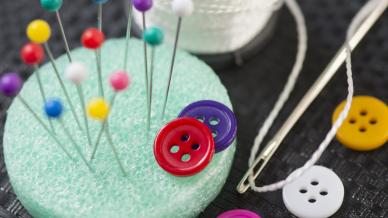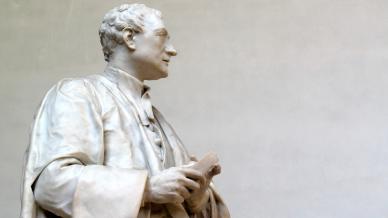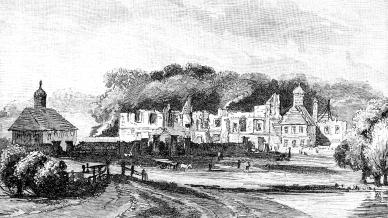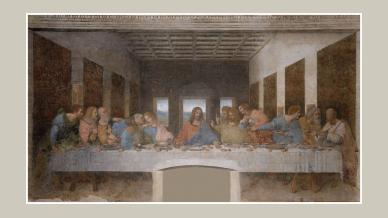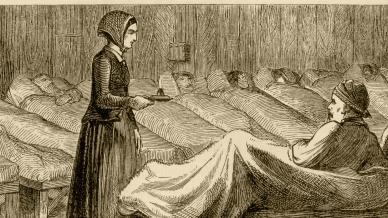1. Good design is timeless
The earliest known sewing needles date back over 50,000 years and were made of animal bone. But the shape and concept are largely the same as needles today, with a long pointy bit and hole at the back (the swaged end) to carry the thread.
2. First line of defence
The diarist Samuel Pepys was well known for his inappropriate behaviour towards women. However, he lamented in 1667 that his advances towards a “pretty, modest maid” in a chapel were thwarted when she took “pins out of her pocket to prick me if I should touch her again — which seeing I did forbear, and was glad I did spy her design”.
3. By royal decree
Pins were such big business in the Middle Ages that various kings and queens of England saw the need to intervene. Richard III banned the import of French pins in 1483 to protect the interests of domestic pinners. Henry VIII created a quality standard for pins, including the need for soldered heads and a smooth, well sharpened shank. Elizabeth I boosted demand single-handedly, by ordering many tens of thousands of pins every season to hold up her opulent dresses, ruffs and wigs.
4. Game-changing innovation
In 1785, the introduction of pin papers increased the ease and safety in carrying pins, and reduced the trade of rusty, headless pins. If a clumsy gentleman stepped on your skirts, then you could retire to a cloakroom and pin up your frock in moments, before returning to the ball. Ornate pin cushions also became a must have to A) avoid losing your favourite pins and B) keep them dry and rust-free.
5. A class above
As with almost everything in snobbish British society, pins were a sign of prestige. The middle and upper classes used short white pins treated with tin oxide to avoid rust, while poorer folk made do with basic red pins. Larger pins, known as caulking or corking pins, were often lavishly decorated to denote wealth and position – and might be handed down as a valuable heirloom.
6. A symbol of capitalism?
The Scottish economist and philosopher Adam Smith used a pin factory in his 1776 Wealth of Nations book as a model for productivity. If each worker specialised in a role – drawing the metal, straightening the shaft, cutting or sharpening etc – then the process would be more efficient (and profitable). This was a forerunner of Henry Ford’s shop floor/assembly line revolution in the early 20th Century.
7. Financial independence
In the 18th and 19th century, the term ‘pin money’ was popularised to describe a monthly allowance paid to wives and daughters to spend at their discretion. It was hers and hers alone. Some women spent their pin money on fripperies like gloves, stockings, fans and ribbons, but others bought books and paper to draw or write poetry and music. Pin money also allowed them to enter libraries, societies and political parties, away from their father or husband’s control.
8. The only way is Redditch
For centuries, the Spanish held a monopoly over needle making, with skilled Spanish refugees ruling the industry in London. But when the Industrial Revolution brought mechanisation, the epicentre of the needle-making globe became Redditch in Worcestershire. By the 20th Century, 90% of the world’s sewing needles were made there. Some 45 million needles were made in Redditch every week. Jealous needle makers in Japan allegedly renamed a suburb of Tokyo, so they could claim their needles were ‘Made in Redditch’.
9. Tragic consequences
In common with most industries of the age, health & safety came second to profit in British needle-making factories. Pointers could sharpen 10,000 needles an hour by holding 100 needles against a grindstone at one go. However, they breathed fine powder from the steel and limestone into their lungs, which caused a fatal pulmonary disease known as Pointer’s Rot. Although well paid at a guinea a day, a pointer’s life expectancy was below 35 years. Moreover, the grindstones occasionally exploded under pressure, sending deadly shrapnel through the factory.
10. “Unscrupulously sacrificed”
Today, we are aware of so-called ‘sweat shops’ that abuse workers’ rights to produce cheap clothing for fast fashion. In Victorian Britain, seamstresses were compelled (there were few other jobs aside from prostitution) to work long hours for a pittance in cold, dimly lit conditions, stitching elaborate designs for society’s elite. Most worked at night, as they raised their children by day. In 1843, a government investigation concluded that 'there is no class of persons in this country, living by their labour, whose happiness, health, and lives, are so unscrupulously sacrificed as those of the young dressmakers'. Cartoonists such as Punch created poignant illustrations that portrayed wealthy debutants with skulls on their blouses and blood on their hands.
Inspired? For more food for thought, why not become a member for £15 a year and enjoy our weekly online lectures.
